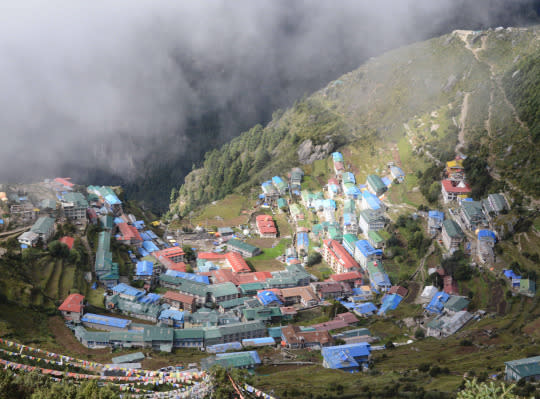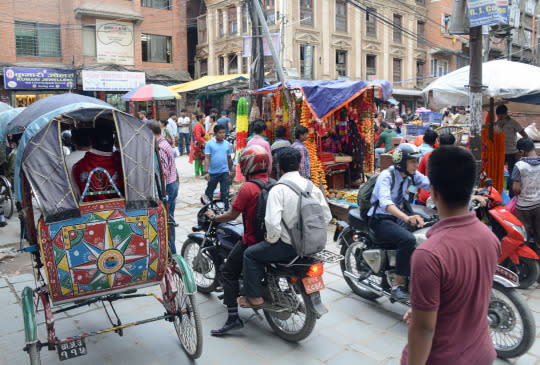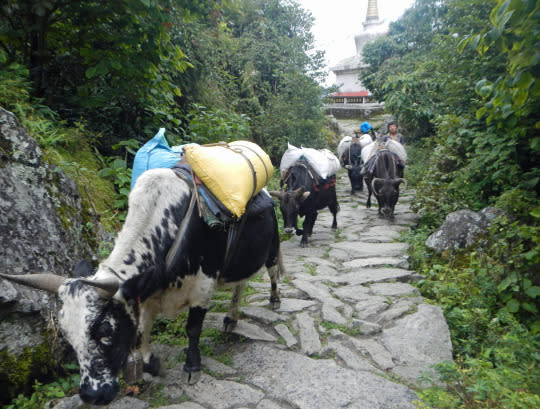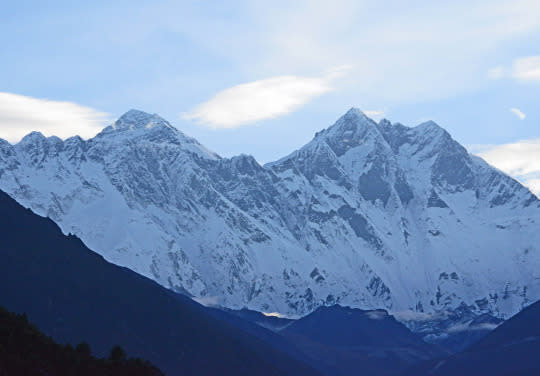Nepal After the Earthquake: Is it Safe to Visit?

The Namche Bazaar, once packed with travelers, was mostly empty on this day even though it’s open for business since the April earthquake. (Photo: Bill Fink)
In April 2015, Nepal suffered a devastating 7.8 earthquake that killed over 9,000 people (including 19 on the slopes of Mt. Everest), destroyed buildings, infrastructure, and created landslides across the country.
Just six months after this disaster, I visited Nepal to check on the state of tourism, to tour Kathmandu, and to join one of the first trekking tours to resume hikes toward Everest Base Camp in the Himalayas.
Nepal: Open for Business
Before flying to Nepal, I spoke with Darrell Wade, the CEO of Intrepid Travel, Nepal’s largest inbound tour operator, about his company’s plans in the country. “After the earthquake hit and we recognized the scope of destruction, we made the decision to halt all tours until the fall.” But now the company is back in a big way.
“We’re running our full slate of tours, and donating all our profits from the 2015-2016 season to charities to help rebuild Nepal,” Wade said of the Intrepid Foundation’s $1 million ”Namaste Nepal” campaign. “Nepal may not be the biggest market for us, but we consider it part of our DNA as an adventure travel company to stay involved.”
“If tourism doesn’t return to Nepal, it’ll be like a second earthquake hitting the country,” Wade said, explaining how tourism supplies funds to a “whole supply chain” of Nepalese, from porters and their families to guest houses, food companies, shops and transport. In October, Intrepid’s bookings were down 25 percent according to local GM Nicholas Cowie, but he told me he’s confident that numbers for them and other companies will be increasing once the word gets out.
Related: Just Back From Nepal: 5 Things You Need to Know After Quake

Kathmandu was in full swing during the visit. (Photo: Bill Fink)
While the Nepal tourism minister announced planned restrictions for permits to summit Mt. Everest’s 29,000-foot peak next year (the proposed measure would ban those under 18, over 75, handicapped, or lacking any experience), the popular regular treks to Everest Base Camp (elevation 17,000) should be unaffected and continue as scheduled, according to Intrepid’s Cowie.
Kathmandu: Rubble and Restoration
Arriving in Kathmandu, there’s no mistaking that this is a city in full swing. Cars, minibuses, motorcycles, bikes, and the occasional sacred cow clog the streets in an intertwined mass of honking, smoke-belching, and weaving traffic that is somehow managed not by stoplights, but by harried traffic cops in intersections. Nearly every block has a building that is either being torn down or rebuilt, and sometimes it’s hard to tell which direction the structure is going.
Related: An Unexpected Gift for Victims of the Nepal Earthquake

Even in the rubble around Durbar Square, daily life went as usual. (Photo: Bill Fink)
Some sections of Kathmandu appear nearly untouched by the earthquake: the famed Swayambhunath “monkey temple” had a few patched-over cracks in its surface but was being mobbed by locals and tourists. The Boudhanath Stupa was undergoing a bit of reconstruction but was similarly crowded with both religious and shopping pilgrims. The downtown Durbar Square, however, still looks like a fresh earthquake zone, with temples reduced to piles of bricks, and buildings precariously supported by bamboo scaffolding and scrap wood. Even here, the streets are passable, the vendors plentiful, and daily life goes on uninterrupted, with motorbikes parked thickly in the “safe zones.”
Kathmandu’s backpacker ghetto of Thamel is alight in neon bar signs and brightly lit mountaineering gear shops, book stores, and souvenir kiosks—missing only the regular crowd of tourists to complete the scene. “Normally there is no room to stand in my store,” said Anu Thapa, who with her husband Pravan run Kaemp 8848, a local boutique producing their own high-end outerwear. “But now, look,” she gestured at the empty space, “This year is totally lost!”

A monkey’s view over Kathmandu. (Photo: Bill Fink)
Thamel’s Kathmandu Guest House, where I (and the Beatles) stayed, has two of its buildings open (and nearly fully booked), but its third, historic tower was so damaged it had to be “dismantled brick by brick,” CEO Rojan Sakya told me. But from his optimistic perspective, “The earthquake was a boon in disguise. Nature has given us the opportunity to rebuild better than ever. I think 2016 is going to be chock-a-block!!!”
Himalayan Trails: The Yaks and Packs are Back
It’s one thing reading a report endorsing the safety of the post-earthquake Everest-area trekking infrastructure and trails, and another thing entirely to ride a small propeller airplane to the cliffside runway at Lukla, elevation 9,200 feet, gateway to the region.
From the plane I spotted some ruined towns, as well as a few landslide-damaged roads. But the water-fed rice terraces still sparkled bright green in the sun, with a backdrop of impossibly high and jagged snow-capped mountains at the horizon.
Related: 16 Towering Facts About Mount Everest

Approaching wire suspension bridges that look over the over the Dudh Kosi River. (Photo: Bill Fink)
Following a heart-palpitating-but-smooth landing, my local guide showed me his family home in Lukla that had been condemned as uninhabitable after the earthquake, his family having now moved to Kathmandu. On the grounds, some hastily constructed huts (“easy down, but easy up again”) housed migrant tenants, with whom we shared some home-brewed rice wine with corn on the cob. I practiced some Nepalese from my Lonely Planet phrasebook to the amusement of the kids.

The hiking trail out of town was in good shape for humans and yaks. (Photo: Bill Fink)
On our hike out of town, I was surprised at how smooth and well-maintained the trail was. Some segments were fully covered in stone, at least 8 feet wide. We crossed five different suspension bridges over the Dudh Kosi River, some swinging a precarious 200 feet above raging rapids easily viewable through the metal slats at my feet. But given that the local porters were carrying multi-hundred-pound loads on their backs across the spans (not to mention the yaks making the crossing), I was confident the wire bridges would hold my weight without trouble. Although we passed many local dwellings damaged or destroyed by the earthquake, only once did we walk through a landslide segment, where a dozen workers were pounding stones to create a new regular trail.
After two days of hiking, I reached the town of Namche Bazaar, elevation 11,300, famous for its weekend markets and normally packed with trekkers. Amid the steady tak-tak-takking sound of hammer on stone from construction work, I walked the nearly empty streets to a feeling of expectation—shop owners were waking up early to put their wares on display, the Danphe Bar continued its 24x7 open-for-business policy, guest houses were putting the finishing touches on their signs. But only a handful of trekkers (mostly from my own Intrepid group) wandered the streets.

The spectacular views of Mt. Everest remain unchanged. (Photo: Bill Fink)
Early the next morning, I hiked above town to catch a clear view of Mt. Everest, looming above the steep peaks at the horizon. I visited the Hotel Everest View to have a cup of tea at “the highest hotel in the world” at 13,000-feet elevation. Aside from the staff, I was completely alone. “Are you remodeling or rebuilding?” I asked. “No we are fully open, tell your friends to visit!” said the manager.
This was the message I heard across all of Nepal during my journey: “We are ready and waiting, please come.”
WATCH: The Ancient, Secret City of Bagan: The Most Zen Place in the World
Let Yahoo Travel inspire you every day. Hang out with us on Facebook, Twitter, Instagram, and Pinterest. Check out our original adventure travel series A Broad Abroad.
